海明威生平英文简介共83页
- 格式:ppt
- 大小:7.82 MB
- 文档页数:83
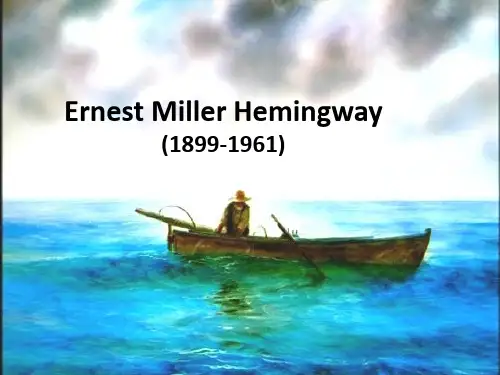

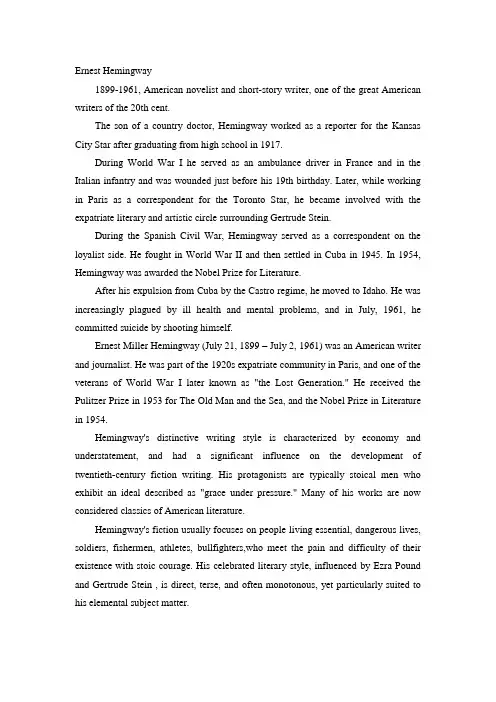
Ernest Hemingway1899-1961, American novelist and short-story writer, one of the great American writers of the 20th cent.The son of a country doctor, Hemingway worked as a reporter for the Kansas City Star after graduating from high school in 1917.During World War I he served as an ambulance driver in France and in the Italian infantry and was wounded just before his 19th birthday. Later, while working in Paris as a correspondent for the Toronto Star, he became involved with the expatriate literary and artistic circle surrounding Gertrude Stein.During the Spanish Civil War, Hemingway served as a correspondent on the loyalist side. He fought in World War II and then settled in Cuba in 1945. In 1954, Hemingway was awarded the Nobel Prize for Literature.After his expulsion from Cuba by the Castro regime, he moved to Idaho. He was increasingly plagued by ill health and mental problems, and in July, 1961, he committed suicide by shooting himself.Ernest Miller Hemingway (July 21, 1899 – July 2, 1961) was an American writer and journalist. He was part of the 1920s expatriate community in Paris, and one of the veterans of World War I later known as "the Lost Generation." He received the Pulitzer Prize in 1953 for The Old Man and the Sea, and the Nobel Prize in Literature in 1954.Hemingway's distinctive writing style is characterized by economy and understatement, and had a significant influence on the development of twentieth-century fiction writing. His protagonists are typically stoical men who exhibit an ideal described as "grace under pressure." Many of his works are now considered classics of American literature.Hemingway's fiction usually focuses on people living essential, dangerous lives, soldiers, fishermen, athletes, bullfighters,who meet the pain and difficulty of their existence with stoic courage. His celebrated literary style, influenced by Ezra Pound and Gertrude Stein , is direct, terse, and often monotonous, yet particularly suited to his elemental subject matter.Hemingway's first books, Three Stories and Ten Poems (1923), In Our Time (short stories, 1924), and The Torrents of Spring (a novel, 1926), attracted attention primarily because of his literary style. With the publication of The Sun Also Rises (1926), he was recognized as the spokesman of the “lost generation” (so called by Gertrude Stein). The novel concerns a group of psychologically bruised, disillusioned expatriates living in postwar Paris, who take psychic refuge in such immediate physical activities as eating, drinking, traveling, brawling, and lovemaking.His next important novel, A Farewell to Arms (1929), tells of a tragic wartime love affair between an ambulance driver and an English nurse. Hemingway also published such volumes of short stories as Men without Women (1927) and Winner Take Nothing (1933), as well as The Fifth Column, a play. His First Forty-nine Stories (1938) includes such famous short stories as “The Killers,” “The Undefeated,” and “The Snows of Kilimanjaro.” Hemingway's nonfiction works, Death in the Afternoon (1932), about bullfighting, and Green Hills of Africa (1935), about big-game hunting, glorify virility, bravery, and the virtue of a primal challenge to life.From his experience in the Spanish Civil War came Hemingway's great novel, For Whom the Bell Tolls (1940), which, in detailing an incident in the war, argues for human brotherhood. His novella The Old Man and the Sea (1952) celebrates the indomitable courage of an aged Cuban fisherman. Among Hemingway's other works are the novels To Have and Have Not (1937) and Across the River and into the Trees (1950); he also edited an anthology of stories, Men at War (1942). Posthumous publications include A Moveable Feast (1964), a memoir of Paris in the 1920s; the novels Islands in the Stream (1970) and True at First Light (1999), a safari saga begun in 1954 and edited by his son Patrick; and The Nick Adams Stories (1972), a collection that includes previously unpublished piecesErnest Hemingway (1899-1961), born in Oak Park, Illinois, started his career as a writer in a newspaper office in Kansas City at the age of seventeen. After the United States entered the First World War, he joined a volunteer ambulance unit in the Italian army. Serving at the front, he was wounded, was decorated by the Italian Government, and spent considerable time in hospitals. After his return to the United States, hebecame a reporter for Canadian and American newspapers and was soon sent back to Europe to cover such events as the Greek Revolution.During the twenties, Hemingway became a member of the group of expatriate Americans in Paris, which he described in his first important work, The Sun Also Rises (1926). Equally successful was A Farewell to Arms (1929), the study of an American ambulance officer's disillusionment in the war and his role as a deserter. Hemingway used his experiences as a reporter during the civil war in Spain as the background for his most ambitious novel, For Whom the Bell Tolls (1940). Among his later works, the most outstanding is the short novel, The Old Man and the Sea (1952), the story of an old fisherman's journey, his long and lonely struggle with a fish and the sea, and his victory in defeat.Hemingway - himself a great sportsman - liked to portray soldiers, hunters, bullfighters - tough, at times primitive people whose courage and honesty are set against the brutal ways of modern society, and who in this confrontation lose hope and faith. His straightforward prose, his spare dialogue, and his predilection for understatement are particularly effective in his short stories, some of which are collected in Men Without Women (1927) and The Fifth Column and the First Forty-Nine Stories (1938). Hemingway died in Idaho in 1961.。
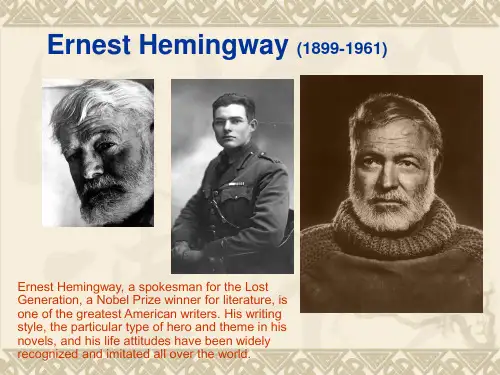
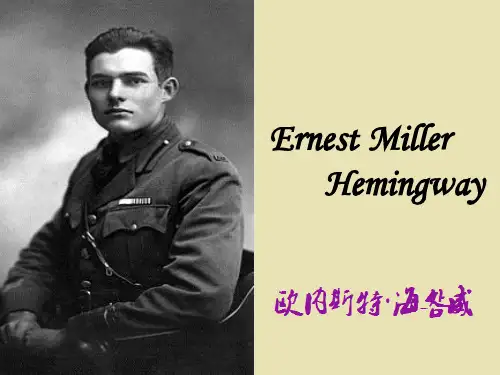
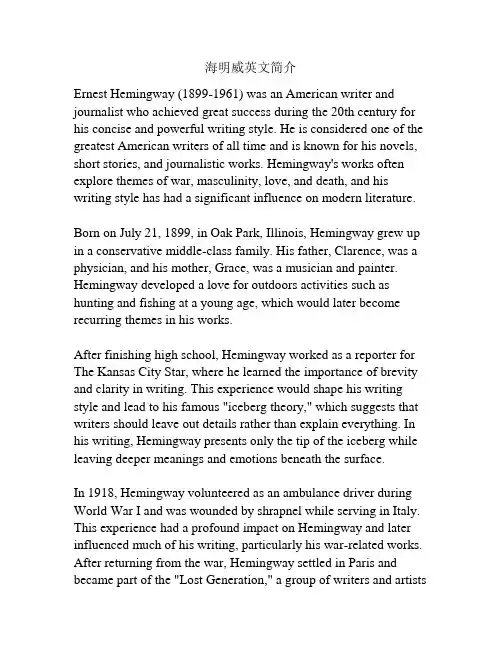
海明威英文简介Ernest Hemingway (1899-1961) was an American writer and journalist who achieved great success during the 20th century for his concise and powerful writing style. He is considered one of the greatest American writers of all time and is known for his novels, short stories, and journalistic works. Hemingway's works often explore themes of war, masculinity, love, and death, and his writing style has had a significant influence on modern literature.Born on July 21, 1899, in Oak Park, Illinois, Hemingway grew up in a conservative middle-class family. His father, Clarence, was a physician, and his mother, Grace, was a musician and painter. Hemingway developed a love for outdoors activities such as hunting and fishing at a young age, which would later become recurring themes in his works.After finishing high school, Hemingway worked as a reporter for The Kansas City Star, where he learned the importance of brevity and clarity in writing. This experience would shape his writing style and lead to his famous "iceberg theory," which suggests that writers should leave out details rather than explain everything. In his writing, Hemingway presents only the tip of the iceberg while leaving deeper meanings and emotions beneath the surface.In 1918, Hemingway volunteered as an ambulance driver during World War I and was wounded by shrapnel while serving in Italy. This experience had a profound impact on Hemingway and later influenced much of his writing, particularly his war-related works. After returning from the war, Hemingway settled in Paris and became part of the "Lost Generation," a group of writers and artistswho were disillusioned by the post-war world.During his time in Europe, Hemingway worked as a foreign correspondent for the Toronto Star, covering events such as the Greco-Turkish War and the Spanish Civil War. His experiences as a war correspondent provided material for his novel "A Farewell to Arms" (1929), which is widely regarded as one of Hemingway's greatest works. The novel tells the story of an American ambulance driver in Italy and his love affair with a British nurse during World War I. It explores themes of love, war, mortality, and the human condition.Hemingway's writing style is characterized by short sentences, simple language, and a focus on actions and dialogues rather than internal monologue. His writing is often described as "masculine" and reflects his interests in masculinity, courage, and stoicism. Hemingway's characters, such as the stoic fisherman Santiago in "The Old Man and the Sea" (1952), often face challenges with courage and grace.Hemingway received the Pulitzer Prize for Fiction in 1953 for his novel "The Old Man and the Sea," which tells the story of an aging fisherman's struggle to catch a giant marlin. The novel explores themes of perseverance, endurance, and the nature of a man's existence. Hemingway considered this novel to be his best work and it contributed to him being awarded the Nobel Prize in Literature in 1954 for his "powerful, style-forming mastery of the art of modern narration."Apart from his novels, Hemingway was also a prolific writer ofshort stories. His collections of short stories, such as "In Our Time" (1925) and "Men Without Women" (1927), showcased his ability to capture moments of human experience in a concise and powerful manner. Many of his short stories are set in exotic locations, such as Africa, Spain, and Cuba, and they often revolve around themes of masculinity, love, and death.In addition to his fiction works, Hemingway wrote extensively about his travels and adventures. His non-fiction works, such as "Death in the Afternoon" (1932) and "Green Hills of Africa" (1935), combine his love for travel, hunting, and writing. Hemingway's writing style, characterized by its authenticity and vivid depiction of landscapes and cultures, has had a lasting influence on travel writing.Tragically, Hemingway struggled with mental health issues throughout his life. He experienced several failed marriages and suffered from alcoholism. In 1961, at the age of 61, Hemingway took his own life in Ketchum, Idaho. Despite his personal struggles, Hemingway's literary legacy lives on, and his works continue to be studied and celebrated by readers and scholars around the world. Ernest Hemingway's concise and powerful writing style revolutionized modern literature. His works reflect his experiences as a war correspondent and his interests in hunting, fishing, and travel. Hemingway's writing explores themes of masculinity, love, and death, and his characters often face challenges with courage and stoicism. His novels, such as "A Farewell to Arms" and "The Old Man and the Sea," are considered classics, and his influence on literature is undeniable. Although he struggled with mentalhealth issues, Hemingway's literary legacy remains one of thefinest contributions to American literature.在过去几十年中,科技的发展以及全球经济的不断增长,给人们的生活带来了巨大的变化。
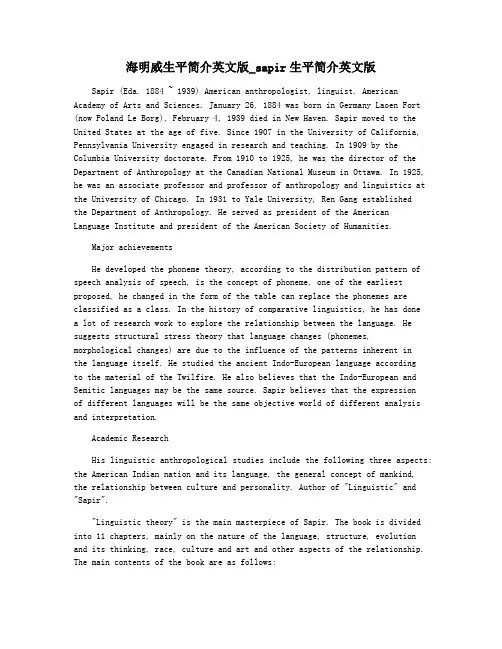
海明威生平简介英文版_sapir生平简介英文版Sapir (Eda. 1884 ~ 1939) American anthropologist, linguist. American Academy of Arts and Sciences. January 26, 1884 was born in Germany Laoen Fort (now Poland Le Borg), February 4, 1939 died in New Haven. Sapir moved to the United States at the age of five. Since 1907 in the University of California, Pennsylvania University engaged in research and teaching. In 1909 by the Columbia University doctorate. From 1910 to 1925, he was the director of the Department of Anthropology at the Canadian National Museum in Ottawa. In 1925, he was an associate professor and professor of anthropology and linguistics at the University of Chicago. In 1931 to Yale University, Ren Gang establishedthe Department of Anthropology. He served as president of the American Language Institute and president of the American Society of Humanities.Major achievementsHe developed the phoneme theory, according to the distribution pattern of speech analysis of speech, is the concept of phoneme, one of the earliest proposed, he changed in the form of the table can replace the phonemes are classified as a class. In the history of comparative linguistics, he has donea lot of research work to explore the relationship between the language. He suggests structural stress theory that language changes (phonemes, morphological changes) are due to the influence of the patterns inherent inthe language itself. He studied the ancient Indo-European language accordingto the material of the Twilfire. He also believes that the Indo-European and Semitic languages may be the same source. Sapir believes that the expressionof different languages will be the same objective world of different analysis and interpretation.Academic ResearchHis linguistic anthropological studies include the following three aspects: the American Indian nation and its language, the general concept of mankind,the relationship between culture and personality. Author of "Linguistic" and "Sapir"."Linguistic theory" is the main masterpiece of Sapir. The book is divided into 11 chapters, mainly on the nature of the language, structure, evolution and its thinking, race, culture and art and other aspects of the relationship. The main contents of the book are as follows:The view of the nature of languageLanguage is not instinctive but social custom. "Speech is a non-instinctive, acquired, 'cultural' function." Here is different from the general view is to highlight the "cultural" function. At the same time that "language is only a habit of sound symbols system." And later mentioned that language is a "tool for expressing meaning". So Sapir's language definition comprehensively sums up what the predecessors say is a kind of communication tool and language is a symbolic system of these two views, and put them organically together.The relationship between language and mindHe speaks the language component as a "concept" symbol, that language mode determines the mode of thinking, and even implies that the language precedes thinking. He said: "Just as mathematical reasoning can not be done with a set of appropriate mathematical symbols, there is no language, thinking and daily use may not be more imagined.Emphasize voice modeThe phonetic model has its psychological basis. He believes that behind the surface of the voice system, "there is a more limited, 'internal' or'ideal' system", the surface system of voice can change, the internal model is unchanged.Distinguish between four categories of grammatical conceptsClass Ⅲ is the concept of spec ific relations, is like "sex", "the class" is the concept of specific relationship, is the basic concept, the basic concept is independent of the word or the root, on behalf of things, actions or nature; Ⅱ class is derived concept, The class is a purely re lational concept, which is a grammatical concept represented by grammatical means such as "lattice" which expresses syntactic relations as well as grammatical means such as word order and function words that express pure syntactic relations.Unique language type insightsHe does not think that the classification of the form does not work, because no language is simple, often can be divided into several morphological types; in the language type of advanced and home is more ridiculous, "every language is like a basic Planning or fixed genre.The language of this type or planning or structure 'nature', than we cite any single phenomenon is morefundamental. " He distinguishes the language from the language according to his expression of the four types of grammatical concepts in different languages.Language, race and cultureHe speaks of the evolution of language as a "flow", which has a general direction, that is, "slope"; language contact is one of the reasons for the evolution of language, but borrow must follow the flow.As for language, race and culture, these three are not necessarily linked. "It is difficult to prove that 'temperament', the overall emotionalinclination of a nation is basically a cultural trend and a determinant of the flow, although it will be revealed when the individual is grasping the composition of the culture.""Language and our ideas are intertwinedly intertwined, in a sense they are the same thing. The basic thinking structure does not show important racial differences, so the infinite variation of language form, that is, thinking Of the infinite variation of the real process, does not point out that there are such important differences in the race, "I do not believe that culture and language really causal relationship.Culture The name can be defined as what a society does and what it is. Language refers to how people think specifically.Language theory"Linguistics" quoted in the language of up to 60 or more, which shows the rich knowledge of Sapir language, especially in the book to provide the American Indian language is even more eye-opener. It has a wide influence on American linguistics.感谢您的阅读,祝您生活愉快。
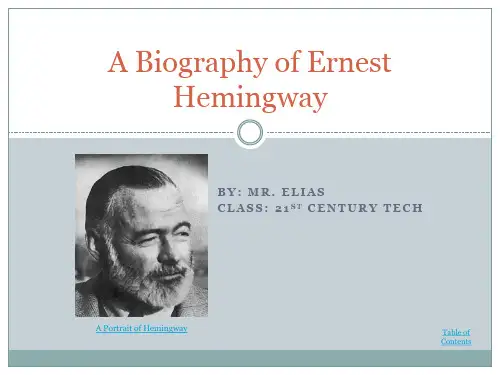

Ernest Hemingway1899-1961, American novelist and short-story writer, one of the great American writers of the 20th cent.The son of a country doctor, Hemingway worked as a reporter for the Kansas City Star after graduating from high school in 1917.During World War I he served as an ambulance driver in France and in the Italian infantry and was wounded just before his 19th birthday. Later, while working in Paris as a correspondent for the Toronto Star, he became involved with the expatriate literary and artistic circle surrounding Gertrude Stein.During the Spanish Civil War, Hemingway served as a correspondent on the loyalist side. He fought in World War II and then settled in Cuba in 1945. In 1954, Hemingway was awarded the Nobel Prize for Literature.After his expulsion from Cuba by the Castro regime, he moved to Idaho. He was increasingly plagued by ill health and mental problems, and in July, 1961, he committed suicide by shooting himself.Ernest Miller Hemingway (July 21, 1899 – July 2, 1961) was an American writer and journalist. He was part of the 1920s expatriate community in Paris, and one of the veterans of World War I later known as "the Lost Generation." He received the Pulitzer Prize in 1953 for The Old Man and the Sea, and the Nobel Prize in Literature in 1954.Hemingway's distinctive writing style is characterized by economy and understatement, and had a significant influence on the development of twentieth-century fiction writing. His protagonists are typically stoical men who exhibit an ideal described as "grace under pressure." Many of his works are now considered classics of American literature.Hemingway's fiction usually focuses on people living essential, dangerous lives, soldiers, fishermen, athletes, bullfighters,who meet the pain and difficulty of their existence with stoic courage. His celebrated literary style, influenced by Ezra Pound and Gertrude Stein , is direct, terse, and often monotonous, yet particularly suited to his elemental subject matter.Hemingway's first books, Three Stories and Ten Poems (1923), In Our Time (short stories, 1924), and The Torrents of Spring (a novel, 1926), attracted attention primarily because of his literary style. With the publication of The Sun Also Rises (1926), he was recognized as the spokesman of the “lost generation” (so called by Gertrude Stein). The novel concerns a group of psychologically bruised, disillusioned expatriates living in postwar Paris, who take psychic refuge in such immediate physical activities as eating, drinking, traveling, brawling, and lovemaking.His next important novel, A Farewell to Arms (1929), tells of a tragic wartime love affair between an ambulance driver and an English nurse. Hemingway also published such volumes of short stories as Men without Women (1927) and Winner Take Nothing (1933), as well as The Fifth Column, a play. His First Forty-nine Stories (1938) includes such famous short stories as “The Killers,” “The Undefeated,” and “The Snows of Kilimanjaro.” Hemingway's nonfiction works, Death in the Afternoon (1932), about bullfighting, and Green Hills of Africa (1935), about big-game hunting, glorify virility, bravery, and the virtue of a primal challenge to life.From his experience in the Spanish Civil War came Hemingway's great novel, For Whom the Bell Tolls (1940), which, in detailing an incident in the war, argues for human brotherhood. His novella The Old Man and the Sea (1952) celebrates the indomitable courage of an aged Cuban fisherman. Among Hemingway's other works are the novels To Have and Have Not (1937) and Across the River and into the Trees (1950); he also edited an anthology of stories, Men at War (1942). Posthumous publications include A Moveable Feast (1964), a memoir of Paris in the 1920s; the novels Islands in the Stream (1970) and True at First Light (1999), a safari saga begun in 1954 and edited by his son Patrick; and The Nick Adams Stories (1972), a collection that includes previously unpublished piecesErnest Hemingway (1899-1961), born in Oak Park, Illinois, started his career as a writer in a newspaper office in Kansas City at the age of seventeen. After the United States entered the First World War, he joined a volunteer ambulance unit in the Italian army. Serving at the front, he was wounded, was decorated by the Italian Government, and spent considerable time in hospitals. After his return to the United States, hebecame a reporter for Canadian and American newspapers and was soon sent back to Europe to cover such events as the Greek Revolution.During the twenties, Hemingway became a member of the group of expatriate Americans in Paris, which he described in his first important work, The Sun Also Rises (1926). Equally successful was A Farewell to Arms (1929), the study of an American ambulance officer's disillusionment in the war and his role as a deserter. Hemingway used his experiences as a reporter during the civil war in Spain as the background for his most ambitious novel, For Whom the Bell Tolls (1940). Among his later works, the most outstanding is the short novel, The Old Man and the Sea (1952), the story of an old fisherman's journey, his long and lonely struggle with a fish and the sea, and his victory in defeat.Hemingway - himself a great sportsman - liked to portray soldiers, hunters, bullfighters - tough, at times primitive people whose courage and honesty are set against the brutal ways of modern society, and who in this confrontation lose hope and faith. His straightforward prose, his spare dialogue, and his predilection for understatement are particularly effective in his short stories, some of which are collected in Men Without Women (1927) and The Fifth Column and the First Forty-Nine Stories (1938). Hemingway died in Idaho in 1961.。
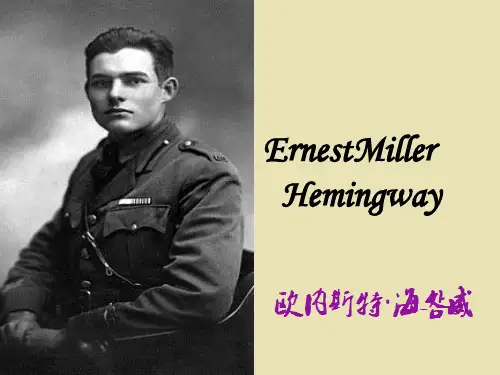

Ernest Hemingway 1899 -1961Life⏹born in a small town called Oak Park in Illinois near Chicago⏹father: a successful physician, middle class, love fishing and hunting;mother: music teacher⏹ a happy childhood; a lover of brutal sports, such as boxing and footballin middle school⏹Though his father hoped him to be a physician, Hemingway refused toenter university. He chose to be a reporter.⏹During the WWI, he wanted to join the army but was refused because ofhis poor eyesight. Then Hemingway came to Italy to work as anambulance driver. He was seriously wounded in the battlefield. Thenightmarish war experience changed his life.Life⏹After the war, he still worked as a reporter. He was sent toParis and knew Pound, Gertrude Stein, SherwoodAnderson and some other famous writers who encouraged him to write.⏹He also worked as a war reporter in the Spanish Civil Warand the WWII.⏹He is a tough guy with rather masculine manner. In all hislife, he loved tough games, such as boxing, hunting, deep-sea fishing, bullfight and so on. He was injured many times.In all the operations, 237 steel fragments were taken outfrom Hemingway’s body. He also suffered 3 car accidents and 2 air crushes. He was admired as a hero by lots ofpeople and his life style was imitated.⏹(9)In 1961, Hemingway shot himself with gun in his home.(also see reference to the handout)⏹(1)“The Sun Also Rises” 1926 (Deep illusion of the wholegeneration after the WWI; the characters indulgedthemselves in depraved life to make themselves numb) ⏹(2)“A Farewell to Arms” 1928 (a tragic story about warand love) (Hero and heroine: Frederic Henry andCatherine Barkley)⏹(3)“For Whom the Bell Tolls” 1940 (Spanish civil war)(also a story about war and love) (the title of the novel: from John Donne’s sermons )(also see reference to the handout)⏹(4)"The Old Man and the Sea” 1952 (In 1954, Hemingway got the Nobel Prize)☐a quite special novel in all his novels☐symbolism⏹Santiago –mankind;⏹sea –nature and environment;⏹marlin –purpose of life;⏹shark –the evil force which control human’s fate☐theme: the importance of life lies in the process ofsearching and resistanceThe Old Man and the Sea by Ernest Hemingway1952OutlineBasic content: context, plot, roles Focal point: the old man’s character, “code hero”Difficult point: the relationship between the old man and the marlin (or the sea)The bleakest ten years1940: For Whom the Bell Tolls1950: Across the River and Into the Trees(self-parody)1952: The Old Man and the Sea(an act of literary revenge)Basic content · roles1.Santiago2.Manolin3.the marlin4.sharks5.the seaCode Hero (Tough Guy)“A man who lives correctly, following the ideal of honor, courage and endurance in a world that is sometimes chaotic, often stressful, and always painful.”------by HemingwayThanks!。
Ernest Hemingway, in full Ernest Miller Hemingway (born July 21, 1899, Cicero [now in Oak Park], Ill., U.S.—died July 2, 1961, Ketchum, Idaho), American novelist and short-story writer, awarded the Nobel Prize for Literature in 1954. He was noted both for the intense masculinity of his writing and for his adventurous and widely publicized life. His succinct and lucid prose style exerted a powerful influence on American and British fiction in the 20th century.The first son of Clarence Edmonds Hemingway, a doctor, and Grace Hall Hemingway, Ernest Miller Hemingway was born in a suburb of Chicago. He was educated in the public schools and began to write in high school, where he was active and outstanding, but the parts of his boyhood that mattered most were summers spent with his family on Walloon Lake in upper Michigan. On graduation from high school in 1917, impatient for a less-sheltered environment, he did not enter college but went to Kansas City, where he was employed as a reporter for the Star. He was repeatedly rejected for military service because of a defective eye, but he managed to enter World War I as an ambulance driver for the American Red Cross. On July 8, 1918, not yet 19 years old, he was injured on the Austro-Italian front at Fossalta di Piave. Decorated for heroism and hospitalized in Milan, he fell in love with a Red Cross nurse, Agnes von Kurowsky, who declined to marry him. These were experiences he was never to forget.After recuperating at home, Hemingway renewed his efforts at writing, for a while worked at odd jobs in Chicago, and sailed for France as a foreign correspondent for the Toronto Star. Advised and encouraged by other American writers in Paris—F. Scott Fitzgerald, Gertrude Stein, Ezra Pound—he began to see his nonjournalistic work appear in print there, and in 1925 his first important book, a collection of stories called In Our Time, was published in New York City; it was originally released in Paris in 1924.In 1926 he published The Sun Also Rises, a novel with which he scored his first solid success. A pessimistic but sparkling book, it deals with a group of aimless expatriates in France and Spain—members of the postwar Lost Generation, a phrase that Hemingway scorned while making it famous. This work also introduced him to the limelight, which he both craved and resented for the rest of his life. Hemingw ay’s The Torrents of Spring, a parody of the American writer Sherwood Anderson’s book Dark Laughter, also appeared in 1926.The writing of books occupied Hemingway for most of the postwar years. He remained based in Paris, but he traveled widely for the skiing,bullfighting, fishing, and hunting that by then had become part of his life and formed the background for much of his writing. His position as a master of short fiction had been advanced by Men Without Women in 1927 and thoroughly established with the stories in Winner Take Nothing in 1933. Among his finest stories are The Killers,The Short Happy Life of Francis Macomber, and The Snows of Kilimanjaro. At least in the public view, however, the novel A Farewell to Arms (1929) overshadowed such works. Reaching back to his experience as a young soldier in Italy, Hemingway developed a grim but lyrical novel of great power, fusing love story with war story. While serving with the Italian ambulance service during World War I, the American lieutenant Frederic Henry falls in love with the English nurse Catherine Barkley, who tends him during his recuperation after being wounded. She becomes pregnant by him, but he must return to his post. Henry deserts during the Italians’ disastrous retreat after the Battle of Caporetto, and the reunited couple flee Italy by crossing the border into Switzerland. There, however, Catherine and her baby die during childbirth, and Henry is left desolate at the loss of the great love of his life.Hemingway’s love of Spain and his passion for bullfighting resulted in Death in the Afternoon(1932), a learned study of a spectacle he saw more as tragic ceremony than as sport. Similarly, a safari he took in 1933–34 in the big-game region of Tanganyika resulted in The Green Hills of Africa (1935), an account of big-game hunting. Mostly for the fishing, he purchased a house in Key West, Florida, and bought his own fishing boat.A minor novel of 1937 called To Have and Have Not is about a Caribbean desperado and is set against a background of lower-class violence and upper-class decadence in Key West during the Great Depression.By now Spain was in the midst of civil war. Still deeply attached to that country, Hemingway made four trips there, once more a correspondent. He raised money for the Republicans in their struggle against the Nationalists under General Francisco Franco, and he wrote a play called The Fifth Column (1938), which is set in besieged Madrid. As in many of his books, the protagonist of the play is based on the author. Following his last visit to the Spanish war, he purchased Finca Vigía (“Lookout Farm”), an unpretentious estate outside Havana, Cuba, and went to cover another war—the Japanese invasion of China.The harvest of Hemi ngway’s considerable experience of Spain in war and peace was the novel For Whom the Bell Tolls (1940), a substantial and impressive work that some critics consider his finest novel, in preference to A Farewell to Arms. It was also the most successful of all his books as measured in sales. Set during the Spanish Civil War, it tells of RobertJordan, an American volunteer who is sent to join a guerrilla band behind the Nationalist lines in the Guadarrama Mountains. Most of the novel concerns Jordan’s relations with the varied personalities of the band, including the girl Maria, with whom he falls in love. Through dialogue, flashbacks, and stories, Hemingway offers telling and vivid profiles of the Spanish character and unsparingly depicts the cruelty and inhumanity stirred up by the civil war. Jordan’s mission is to blow up a strategic bridge near Segovia in order to aid a coming Republican attack, which he realizes is doomed to fail. In an atmosphere of impending disaster, he blows up the bridge but is wounded and makes his retreating comrades leave him behind, where he prepares a last-minute resistance to his Nationalist pursuers.All of his life Hemingway was fascinated by war—in A Farewell to Arms he focused on its pointlessness, in For Whom the Bell Tolls on the comradeship it creates—and, as World War II progressed, he made his way to London as a journalist. He flew several missions with the Royal Air Force and crossed the English Channel with American troops on D-Day (June 6, 1944). Attaching himself to the 22nd Regiment of the 4th Infantry Division, he saw a good deal of action in Normandy and in the Battle of the Bulge. He also participated in the liberation of Paris, and, although ostensibly a journalist, he impressed professional soldiers not only as a man of courage in battle but also as a real expert in military matters, guerrilla activities, and intelligence collection.Following the war in Europe, Hemingway returned to his home in Cuba and began to work seriously again. He also traveled widely, and, on a trip to Africa, he was injured in a plane crash. Soon after (in 1953), he received the Pulitzer Prize in fiction for The Old Man and the Sea(1952), a short heroic novel about an old Cuban fisherman who, after an extended struggle, hooks and boats a giant marlin only to have it eaten by voracious sharks during the long voyage home. This book, which played a role in gaining for Hemingway the Nobel Prize for Literature in 1954, was as enthusiastically praised as his previous novel, Across the River and into the Trees(1950), the story of a professional army officer who dies while on leave in Venice, had been damned.By 1960 Fidel Castro’s revolution had driven Hemingway from Cuba. He settled in Ketchum, Idaho, and tried to lead his life and do his work as before. For a while he succeeded, but, anxiety-ridden and depressed, he was twice hospitalized at the Mayo Clinic in Rochester, Minn., where he received electroshock treatments. Two days after his return to the house in Ketchum, he took his life with a shotgun. Hemingway had married four times and fathered three sons.Hemingway left behind a substantial amount of manuscript, some of which has been published. A Moveable Feast, an entertaining memoir of his years in Paris (1921–26) before he was famous, was issued in 1964. Islands in the Stream, three closely related novellas growing directly out of his peacetime memories of the Caribbean island of Bimini, of Havana during World War II, and of searching for U-boats off Cuba, appeared in 1970.Hemingway’s chara cters plainly embody his own values and view of life. The main characters of The Sun Also Rises, A Farewell to Arms, and For Whom the Bell Tolls are young men whose strength and self-confidence nevertheless coexist with a sensitivity that leaves them deeply scarred by their wartime experiences. War was for Hemingway a potent symbol of the world, which he viewed as complex, filled with moral ambiguities, and offering almost unavoidable pain, hurt, and destruction. To survive in such a world, and perhaps emerge victorious, one must conduct oneself with honour, courage, endurance, and dignity, a set of principles known as “the Hemingway code.” To behave w ell in the lonely, losing battle with life is to show “grace under pressure” and constitutes in itself a kind of victory, a theme clearly established in The Old Man and the Sea.Hemingway’s prose style was probably the most widely imitated of any in the 20th century. He wished to strip his own use of language of inessentials, ridding it of all traces of verbosity, embellishment, and sentimentality. In striving to be as objective and honest as possible, Hemingway hit upon the device of describing a series of actions by using short, simple sentences from which all comment or emotional rhetoric has been eliminated. These sentences are composed largely of nouns and verbs, have few adjectives and adverbs, and rely on repetition and rhythm for much of their effect. The resulting terse, concentrated prose is concrete and unemotional yet is often resonant and capable of conveying great irony through understatement. Hemingway’s use of dialogue was similarly fresh, simple, and natural-sounding. The influence of this style was felt worldwide wherever novels were written, particularly from the 1930st hrough the ’50s.A consummately contradictory man, Hemingway achieved a fame surpassed by few, if any, American authors of the 20th century. The virile nature of his writing, which attempted to re-create the exact physical sensations he experienced in wartime, big-game hunting, and bullfighting, in fact masked an aesthetic sensibility of great delicacy. He was a celebrity long before he reached middle age, but his popularity continues to be validated by serious critical opinion.Philip YoungEd.欧内斯特·海明威,在全欧内斯特·米勒海明威(出生于1899年7月21日,在橡树园西塞罗(Cicero)[],伊利诺伊州,美国死于1961年7月2日,凯旋,爱达荷州),美国小说家和短篇小说作家,被授予了诺贝尔文学奖于1954年。
海明威英文简介欧内斯特米勒海明威简介Ernest Miller Hemingway (July 21, 18101 - July 2, 1961), was born in the United States, Illinois, Chicago suburb of Oak Parker, American writer, journalist, is considered to be 20 One of the most famous novelists of the century.Hemingways life has won many awards. He was awarded the bravery medal during the First World War; in 1953, he won the Pulitzer Prize for the book The Old Man and the Sea (1); the 1954 Old Man and the Sea won Hemingway Bell Prize for Literature. In 2021, Hemingways The Sun Also Rises and Farewell to Arms were included in the Best English Novels of the 20th Century by the American Modern Library.July 2, 1961, Hemingway in Idaho Ketchums home with a shotgun committed suicide.Hemingways feelings in the complex, has concluded four marriages, is the United States Lost Generation (Lost Generation) writers in the representative of the works of life, the world, society has shown a confused and anxious. He has always been known as the literary tyk, he is the spirit of the American nation monument. Hemingways work marks the formation of his unique creative style, in the history of American literature and even the history of the world literature occupies animportant position.欧内斯特米勒海明威创作特点language styleSimpleHemingway has excellent language control ability. He often expresses the most complicated content in the simplest vocabulary. It expresses the concrete meaning with the basic vocabulary, the simple sentence and so on. He uses nouns and verbs to reveal the true face of things. From the point of view, Hemingway often used a brief statement of language expression, he believes that there is no need to use text modification carved to grandstanding, as long as the things described clearly on the line, the other by the reader to decide. Such as the old man and the sea in the old man with a harpoon frog big fish scene, the author described as the old man put down the fishing line, the harpoon held as high as possible, resorted to the strength of the body, plus he just Strength, put it straight down into the side of the fish. In these descriptions the author did not use any modified ingredients, but the verb, the noun is a simple combination to describe a thrilling scene. In this plain language, people can feel the profound artistic realm and art at the end, this rustic language also makes Hemingways works have more affinity and authenticity.Hemingways novel language has the characteristics of notredundant, simple style, simple sentence, simple words, he often use the basic word as the center to construct a single sentence, rarely use the expression of ideas adjectives and adverbs. In the twenty-sixth chapter of the Farewell to Arms, there was a dialogue between Henry and the priest about the war. The dialogue was very concise, concise, without any glitzment, but from which the reader could feel the people Of disgust. In the novel killer, the use of a lot of concise phrases, in the form of colloquial dialogue to start the plot, through the dialogue to avoid a lot of explanation and complex background account, giving an immersive feeling.IntuitiveLiterature and art to express emotions, but the emotion is to rely on the appearance of things perspective, the more the appearance of things directly described, the more able to produce a strong visual authenticity, the more able to narrow the distance between the reader and the writer. Hemingway with a high degree of visualization of the language, the visual, olfactory, auditory and other senses into the language, write the shape of things, color, taste, etc., with direct visual performance of the universe and life. As in the snow of Kilimanjaro, Hemingway wrote that the man was lying on the canvas bed, and he looked over the shy shade of the shy tree to the suns dazzling plain, with three huge birds hugging, and Many in the wings soar. Hemingway with this simple, simplelanguage is to highlight the image of the clarity and visual sensitivity. The formation of this language style is closely related to the Impressionist Master Cezanne, who learned how to control the readers eyes from Cezanne, as in the early novel In the North of Michigan, Hemingway focused on the young girl, Cotz body, with her eyes describe the scene, in order to suggest its pure innocence, optimistic and naive, full of longing for the future.The use of compound sentences and clauses is more in line with formal style, but the sentence is too long to make people look more strenuous, so Hemingway in the dialogue to strive to overcome this shortcoming, with simple, smooth, vivid sense of rhythm to express The movement of the characters, this text can often produce visual effects, to the reader to bring a visual impact. Such as the elderly and the sea, the Marlins dragged the old man Santiago swim day and night, the elderly almost fainted, but still insist on not giving up, then the author with a very simple words pull ah, hand Ah, he thought, stood firm, legs, accurately expressed the fatigue of the elderly, resulting in a strong visual and psychological feelings. In the short story white elephant mountain at the end of the author to take the trouble to repeat Please ask you, please, please, please, beg you, beg you, I beg you The image expresses the girls upset and produces a strong visual impact.Implicit emotionHemingway has his own special artistic style, he emphasizes the objectivity of writing and the idea of the implicit implicit, against the author directly to the characters comment and implied, he often used implicit language to express complex emotions, with a limited form of expression of endless connotations , So his novels in the appearance of quietly, but the inner feelings are rich and hot. Iceberg principle is Hemingways creative principle, he insisted that the complex social life should be extracted from the most characteristic of the plot, his thoughts and feelings hidden, in accordance with the iceberg principle left seven seven feet of space Readers think and try to figure out. Such as farewell, weapons, the outcome, Henry regardless of the nurses insidious to see his wifes remains, but to see his wife when the body did not have a statement, nor a tear, this silent farewell to do not explain and get explained, Alienated and cold and the realization of the purpose of care, to achieve here silent victory effect. Hemingway often through the image of the characterization of the inner world of the characters hidden behind, through the performance of the material world to the reader to think, to imagine that this writing is a few pen, but it is into the wood, the characters Portrayed, showing a do not yield to the fate of the tough guy spirit.Hemingway often struggles to get rid of the influence of subjective feelings on the work, with a near objective way to express theiremotions, which is often demoted as dumb cattle. In fact, critics only flow in the works of appearance, do not understand the feelings of the authors heart. German writer Ryder has said that Hemingway through the indifferent to reach the excitement, without explanation to be explained. In the white elephant mountains almost all dialogue, works almost do not see the trail of the author, but in the dialogue but there are deep connotation. In addition, Hemingway is very good at using language ambiguity to express symbolic and ideological content. Such as farewell, weapons, the weapons have two meanings, on the one hand the meaning of war, on the other hand is the meaning of love, it symbolizes the two themes of the novel against war and farewell to love; Mountains , elephant is not only the meaning of elephants, there are useless, cumbersome meaning.DialogueFrom the narrative approach, Hemingways novels dialogue is show rather than tell. It is a kind of perfect imitation that belongs to Plato, rather than the kind of pure narrative that it wants to create a different degree of imitation of the illusion that is the poets endeavor to cause him not to speak But a person in the illusion of speech. Compared to the two, pure narrative narrative and event distance, as pure imitation directly. The dialogue gives the narrator complete the character, which pushes the imitation of the utterance to the extreme, completelyobliterating the traces of the narrative, giving the words to the characters and occupying the front desk. In this case, the shadow of the author subsided, as if there were only people in the story, without the narrator, the story of the person, in other words, the narrator did not intervene or seldom intervene in the narrative, Under the traces of. This narrative approach, in terms of its distance from the object being described, is very close, almost equal to zero; it is subtle in terms of the narrative information it conveys. Hemingway use the narrative means of dialogue, its intention is show, the pursuit of perfect imitation. In the Kilimanjaro snow, in order to highlight the dialogue, the opening is the dialogue, very unexpected, this is the display of the narrative style.In order to meet the concise expression of this expression, his dialogue as much as possible to write a very good understanding, not esoteric words, without big words, and small words, as long as the reader in accordance with the order to read down, fully understand the words of each speaker is Who. In addition, each participant in the dialogue is generally two, one question and answer, or chat, or controversy. The reason why the two people to maintain this measure, rather than a number of people, because many people, in the absence of the name of the speaker in the case of the reader is not easy to find out which one, which is very important. When there is a third person or more conversation, Hemingway must indicate the name of the speaker.Hemingway also wrote style of spoken, his dialogue sentence is short, simple structure, there is no gorgeous rhetoric. This style of spoken language is characterized by the use of the American Midwest peoples spoken language and its rhythm, but also mixed with different local language, the language of the ancient Havana, the Spanish language of the Guadalrama, Spanish English; The language of the fisherman, the language of the bullfighter, the language of the hunter, etc., read the sound of the sound, often to the reader a real language illusion. They use the vocabulary, pronunciation methods are not the same. We say that Hemingways novels are never fancy, and are used to avoid adverbs, adverbs and other modifiers. This is reflected in many aspects. The dialogue is no exception. We can also say that it is because of the large number of dialogues used in Hemingways novels. Therefore, the large tracts of the daily language of the novel caused the overall simplicity of the novel. In modern narratology, the narrative means varied and varied. Hemingways love of this unique narrative style, the reason is: the use of structuralism, distance and angle theory to observe, the dialogue can make the reader feel immersive, and the narrative is difficult to achieve This realistic effect. In addition, the dialogue is more concise than the narrative, but also more vivid sense, implication is more abundant. In view of the dialogue with such a great superiority, the novel master Hemingway did not hesitate to adopt it, and its charm to anunparalleled degree, making his novel unique, dominate.Relationship between men and womenFrom the theme of the relationship between men and women to analyze Hemingway, it is easy to see, despite the keen to describe the mans wild and heroic, Hemingway has indirectly expressed his fear and hatred of women. His code heroes (code heroes) are fighting alone, even if the woman has any relationship, and ultimately to be separated. Strong sense of destiny and death in his works to be generally reflected. Its masterpiece old man and the sea is a sketch of a purely male world. DH Lawrence observed a pattern of men and women in Hemingways short story: A person wants to be free. Just avoid one thing: get involved in it. Never be involved. If you are caught by something, get rid of it. Get rid of it and leave.For example, this is about Robert Jordan in the Spanish civil war to participate in a bombing bridge mission story, which interspersed with Jordan and Marias romantic love, they only have three days of romance, Jordan retreat When the legs were seriously injured, and Maria can not go to Madrid. Three days in the mountains is the best of Jordans life, he and Marias love, although short, but to achieve the eternal, Jordans love in the revolution before the cause of the sacrifice. He knew that he was still in danger and was dedicated to the Spanish people. However, from another point of view, this choice also reflects the cruelty of Hemingway.He did not know if Jordan and Maria jointly safe withdrawal is a sign that the beginning of a better life. He would rather choose to gloriously die, rather than romantic together for life. In the farewell, weapons, Henry did not start to Catherine seriously, and that is just a game. Its better than going to the house every night, its a game, just like playing a bridge, but its not playing cards, but talking. For example, when Catherines surgery was Henrys monologue, critics That Catherines death and Henrys hostility to her, in the last chapter, when Catherines surgery, a short period of time, Henry 19 thought Catherine will die, dead the recurrence of the word seems to be With the magic of the general anxiety, when Catherine on the operating table full of painful bleeding, Henry twice out to drink, but also eat something - because he was hungry. When he came back, Catherine was dead. And then in the foreign land in the major and I dialogue, for example, this story mentions that the young wife died of pneumonia:Why should not men get married?No, thats it should not be done, he said angrily. Even if a man is destined to lose everything, at least not to make himself fall to the point where he is to be lost, he should not let himself fall into that situation, and he should find something that will not be lost.Major words, but also Hemingways inner monologue. Hemingway with his pen will be a woman in the novel one by one death, the hero istough guy, endured the spirit and physical pain. In Hemingways novel, we can see this phenomenon, a good woman will eventually die or have passed away. As the old man and the sea only once mentioned the wife of Santiago is the wall was once hanging his wifes color, but he took it off, because he felt too lonely This is Hemingway ideal Love end: the old couple spent a lifetime of good times, good wife has passed away, widower fishing alone at the beach.After the above analysis, it can be concluded that in Hemingways novels, the separation of men and women is usually based on a powerful external force - in the form of extreme death. In his first novel, Jack and Brett were separated from Jacks sexual incompetence, as in his three novels, The Sun Also Raises, Farewell, Weapons and The Whip Bell ; The second novel in the separation of male and female heroes died of Catherine dystocia; in the third novel, the hero Robert Jordan for the cause of justice and dedication. Hemingway seems to use this so-called fate factor to cover up his fear of living with women.海明威英文简介相关11/ 11。